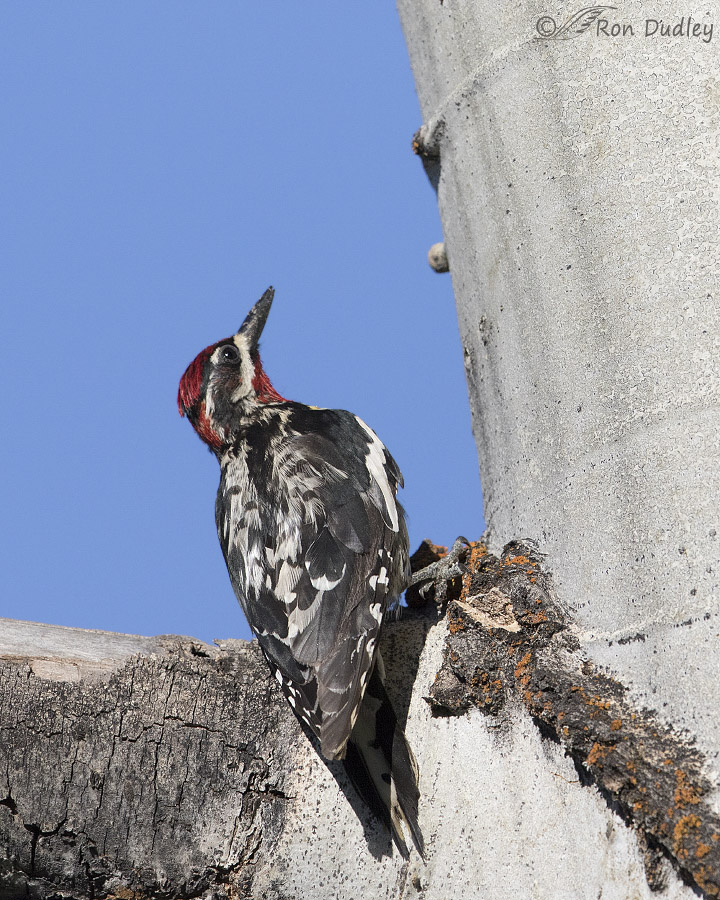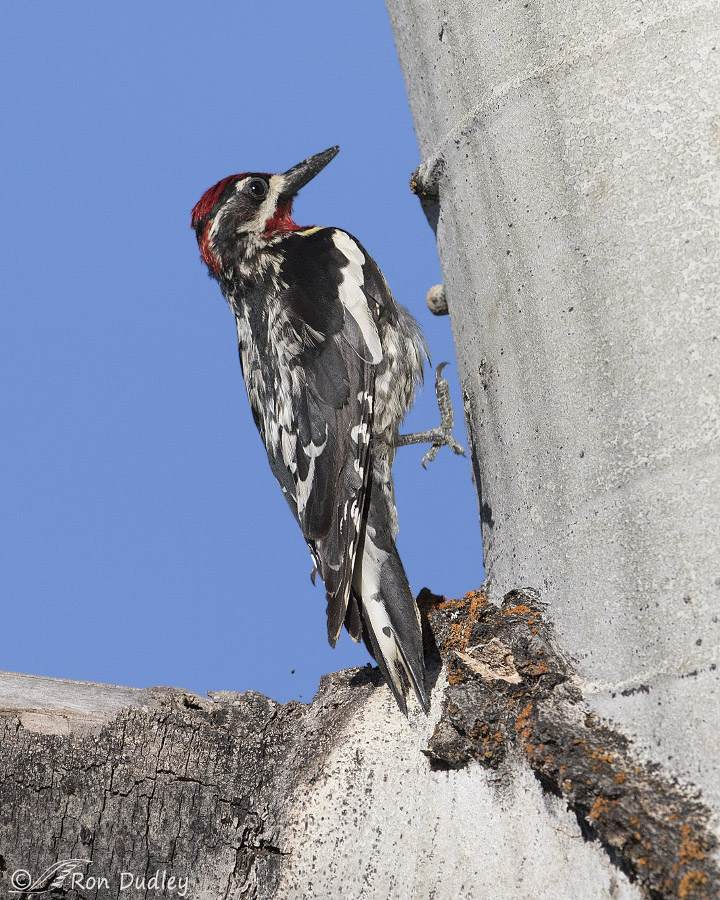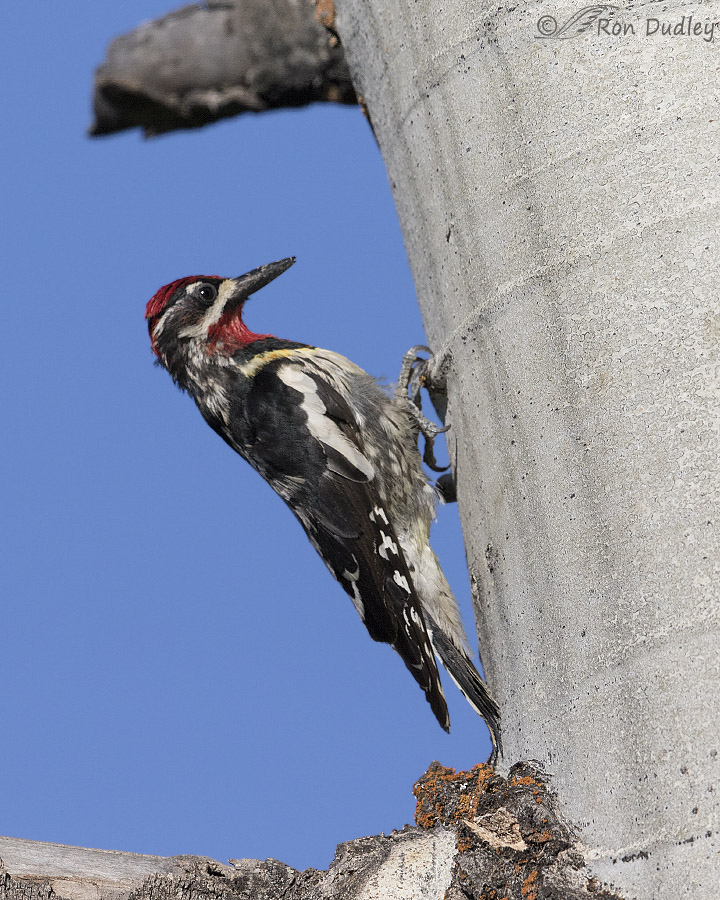Weight saving strategies of birds for flight also serve them well whenever they feel the need to simply jump. And most can jump very well.

1/6400, f/5.6, ISO 800, Canon 7D Mark II, Canon EF 500mm f/4L IS II US, not baited, set up or called in
I photographed this male (I believe) Red-naped Sapsucker about six weeks ago in Idaho’s Targhee National Forest. When he looked up the tree trunk like this I didn’t know if he was going to fly or jump or what, but my instincts told me to pan upwards for whatever might happen so that’s what I did.
These three images in a burst are sequential and in the next shot I was lucky enough to…

1/6400, f/5.6, ISO 800, Canon 7D Mark II, Canon EF 500mm f/4L IS II US, not baited, set up or called in
catch the bird in mid-air as he jumped straight up the trunk without ever opening his wings. For whatever reason he had for going there his intention was to use his claws to grab onto the bump in the circular swollen ridge on the tree directly in front of his neck. Since the tree was leaning toward him he needed something to grab onto.

1/6400, f/5.6, ISO 800, Canon 7D Mark II, Canon EF 500mm f/4L IS II US, not baited, set up or called in
And he succeeded. But what impressed me was his jumping ability. He had to jump straight up for roughly the distance he is tall and then grab onto the bulge as he angled his body backwards to match the angle of the tree. And he did it without using his wings. That would be like me (even as a teenager) jumping straight up almost six feet – ain’t gonna happen.
Birds have evolved many interesting weight-saving devices for flight that also aid them in jumping. They include:
- Lightweight hollow bones
- No teeth or jawbones (both would be heavy). Instead they have a lightweight beak
- Ovaries and testes are exceptionally small for most of the year – they only enlarge during the breeding season
- Females have only a single ovary (instead of two)
- No urinary bladder
- Feathers are made of lightweight keratin and their shafts are hollow
- Many of their bones are fused which not only supplies rigidity to the body during flight (a distinct advantage) but it reduces the need for relatively heavy soft tissues (including tendons and muscles) that would be needed to manipulate unfused bones and hold them together
To put some perspective on it this 8.5″ sapsucker weighs only 1.8 oz. Mammals of a similar size weigh significantly more.
And it goes without saying that all of these adaptations for flight also make many birds good jumpers. And extremely quick – much to the dismay of this bird photographer who ends up with so many “air shots”.
Ron
PS – My incredibly fast shutter speed resulted because the bird suddenly moved to where it had bright blue sky for background and I shoot in aperture priority.


Some very interesting information….
Thanks, Patty.
Starting my day awed, full of wonder and gratitude again. Megathanks. When daylight comes round the day will be busy and fraught so the gratitude for starting it well is VERY real.
“When daylight comes round the day will be busy and fraught so the gratitude for starting it well is VERY real.”
That makes me feel good, EC. Improving your day makes my day.
Wonderful shots of a behvior we seldom see without long observations Is there any aspect of birds that is not fascinating? Not so for me. And sometimes the exceptions are also fascinating. As you said, birds have hollow bones (no marrow but crosswise struts that give support) butt hey are denser than mammal bones. But there is always an exception. Loons have solid bones and penguins and alcids have bones that are far less hollow than most birds. We assume this helps with diving in these birds. Another interesting exception: As you say, most birds have only one functional ovary (the right one degenerates early in embryonic development), but some raptors are an exception. Some have been found with two ovaries with the left being larger. A study in Britain found many harriers with 2 functional ovaries. Studying birds is fun
Interesting stuff, Dan! Thanks for providing it.
And I had no idea that a few birds DO have a full sized, fully functional right ovary! Fascinating.
It is fun, isn’t it? Whenever you’ve reached the end of your without learning something new, just open up one of your big bird books. There’s ALWAYS something new to learn and ponder with these fascinating critters!
Wow — cool Dan! Thanks for the additional info. I just LOVE learning new stuff — especially about nature!
Again, I harken back to our comparative inadequacies in the athletic department! Yeah, we’re not gonna make a jump like that happen–not ever!
But I need to quibble with one of your statements about “lightweight hollow bones.” Their bones aren’t hollow, but instead feature a lightweight honeycomb structure–at least in raptors. I’m not 100% sure that holds true for sapsuckers, but I suspect it does.
One little fact that routinely boggles my mind is that the sum weight of their feathers exceeds the weight of their skeleton! It’s not by much, but still. Really? Just WOW! Evolution is so darn intelligent, morphing into the needed realities to fit what’s needed. Just WOW! But it makes me wonder why we developed as we did, but that’s a whole ‘nother discussion.
And, as always, what glorious images, but there we go with the ridiculous redundant redundancies again
Thanks, Laura.
Hollowness is a matter of degree, isn’t it. There’s lots of variation between groups of birds, some bones have crisscrossing struts in the otherwise hollow core of the bone and in many bones the hollow cavity is largely filled with air sacs. But I stick with my simplified statement that birds have lightweight hollow bones (they have no marrow). True the same amount of bone material in a bird is more dense than that same amount of a mammal’s but since bird’s bones are largely hollow the overall weight of equal sized bones in the two groups is lighter in birds. At least that’s my understanding…
First, I truly recognize that I’m only right sometimes, and even then, I could still be wrong. I’m no expert on anything–just ask Mariah, Jack, Skye and the dogs! But I digress. And there’s also the issue that my knowledge level plummets when we get outside of redtails, Harris’ hawks and Kestrels. I hope to expand it a bit soon.
And there’s also the issue that my knowledge level plummets when we get outside of redtails, Harris’ hawks and Kestrels. I hope to expand it a bit soon.
For whatever it’s worth, dictionary.com defines hollow as “having a space or cavity inside; not solid; empty,” while Merriam-Webster’s definition is “an unfilled space.” To me, that suggests that to be truly hollow, there must be nothing inside the external structure but air(?). Thus, “if something is hollow, it is empty on the inside. A chocolate Easter bunny looks like so much chocolate until you realize that it is hollow and quickly eaten” according to Vocabulary.com.
The intricate internal honeycomb structure of a redtail’s (and most other raptors) leg bones says to me that it’s not truly hollow. But that’s just me. Again, I’m no expert! Trust me on this!
Now all that said, I can see your points, too. There are so precious few completely right answers in this world. Yes, there is the matter of degree. Now scratching my head again! Your words give me something to ponder today!
I really hate it when my computer decides what I’ve written needs to be summarily deleted, especially when there’s no recovery option! It was hard enough to write my words in the first place! Computers are EVIL!! This one decides that a certain subset of my words have to go, selects the specific text for deletion and deletes all while I’m typing. It happens in a nanosecond. I have NO idea what I’m doing to inspire that action and it’s starting to really make me mad!
It’s spectacular that you were able to capture this bird’s spectacular jumping skills. (I feel like I’m leaving a Laura Culley comment with those words.) I am amazed at the kinds of things birds can do. But then, they need those skills to survive under frequently difficult circumstances. I’m also impressed that you were able to capture the bird in the airborne phase of the jump.
Thanks very much, Susan.
You are absolutely right Ron it is a male because there is no white along with the red under the bill, the throat is completely red.
How about kid being able to jump his height? All I can remember I was able to do a heck of lot when I was a kid, but having to train and work hard to even come close when I was a teenager! Height and pounds prevents us from even coming close!
Great information Ron, a very interesting post!
Thanks, Dick. I hedged my bet on calling the sex of this bird because some females don’t show that white on the throat.
WOW! That’s impressive! Both the bird and catching the action. Biology lesson always welcome also.:) A “first” yesterday – Belted Kingfisher hit the picture window! Didn’t break the window, just stunned so brown paper bag in a cool place for awhile and off it went. Was nice to view on up close – it’s speckled back and wings are VERY beautiful.
Wow, I’m glad your kingfisher recovered, Judy. Close call!
Coolamatious shot, Ron! Plus, fascinating info — I had no idea about the reproductive adaptations. It’s gonna be a good day when I learn something new and interesting before the sun even comes up!
I think that reproductive adaptation is pretty neat, Marty. I know of no other vertebrates who only have one ovary.
There are apparently a few fish that have only one functional ovary. This adaptation corelates with egg size and these fish lay very large eggs. Birds also lay very large eggs with respect to body size. S I mentioned in my earlier response, some harriers have 2 functional ovaries. It is interesting to note that harrier eggs are smaller than many other similar sized birds.
More interesting stuff, Dan. I’m going to have to do a little research on those fish with only one ovary – that’s new to me.
Fish sex is just plain weird all around!
I agree, Marty.
It’s even more stunning than if he’d jumped “straight up”– the mass of his body isn’t OVER his legs and feet, it’s actually mostly behind them– wow !
Interesting observation, Kris. Thanks.
Sensationa Ron!
Charlotte
Thanks, Charlotte.